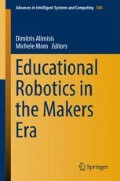Abstract
In this paper, the development of an Orbital Robotics educational prototype platform is presented, consisting of a hardware-developed physical system and an accompanying set of curriculum-based lessons (IB Physics curriculum) that target upper secondary students (16–18 years old target group). The platform was the outcome of a joint project between the European Space Agency and the National Technical University of Athens. The students use the hardware interactively, consisting of a bespoke space-emulating table and small satellite mockups. The lessons are inquiry-based and are structured so that the students are actively engaged in the learning process, according to a learner-centric approach. During the lessons, this platform allows students to acquire knowledge of the dynamics of space systems, as well as of the environmental conditions and physical constraints that characterize on-orbit operations. Students are able to manipulate the space robot (satellite) mockups performing basic tasks such as docking and landing, or grasping space debris. Additionally, a smartphone application has been implemented to allow the interaction with the platform, via a dedicated User Interface (UI).
Access this chapter
Tax calculation will be finalised at checkout
Purchases are for personal use only
References
Eguchi, A.: Robotics as a learning tool for educational transformation. In: Proceeding of 4th International Workshop Teaching Robotics, Teaching with Robotics and 5th International Conference Robotics in Education, Padova, Italy, pp. 27–34 (2014)
Nugent, G., Barker, B., Grandgenett, N., Adamchuk, V.I.: Impact of robotics and geospatial technology interventions on youth STEM learning and attitudes. J. Res. Technol. Educ. 42(4), 391–408 (2010). Taylor & Francis
Christofi, N., Talevi, M., Holt, J., Wormnes, K., Paraskevas, I., Papadopoulos, E.: Orbital robotics: a new frontier in education. In: 6th International Conference on Robotics in Education (RiE 2015), Yverdon-les-Baines, Switzerland (2015)
Tokuhama-Espinosa, T.: Why mind, brain, and education science is the “New" brain-based education. New Horiz. Learn. 9(1) (2011)
Thinking Styles. http://www.robertjsternberg.com/thinking-styles/
McCarthy, B., McCarthy, D.: Teaching around the 4MAT Cycle: Designing Instruction for Diverse Learners with Diverse Learning Styles. Corwin Press, Thousand Oaks (2006)
Pearman, R., Albritton, S.: I’m Not Crazy, I’m Just Not You: The Real Meaning of the 16 Personality Types. Nicholas Brealey Publishing, London (2010)
The Myers Briggs Type Indicator (MBTI), The 16 Personality Types. http://www.myersbriggs.org/my-mbti-personality-type/mbti-basics/the-16-mbti-types.htm
Schwartz, J.L., Peck, M.A., Hall, C.D.: Historical review of air-bearing spacecraft simulators. J. Guidance Control Dyn. 26(4), 513–522 (2003)
ARDUINO. http://www.arduino.cc
Acknowledgment
The authors would like to thank the ESA Automation and Robotics Laboratory (ARL) for providing their facilities and assistance throughout the development of the project, and the head of the Automation and Robotics Section, Gianfranco Visentin, as well as Kletil Wormnes, ESA mechatronics engineer, Monica Talevi, Head of Coordination and Outreach Unit, Education & Knowledge Management Office, and Slawomir Zdybski, ISS and International Education Operations Coordinator, for their continued mentorship and support.
Author information
Authors and Affiliations
Corresponding author
Editor information
Editors and Affiliations
Rights and permissions
Copyright information
© 2017 Springer International Publishing AG
About this paper
Cite this paper
Christofi, N., Papadopoulos, E.G., Paraskevas, I.S. (2017). Orbital Education Platform: Introducing Orbital Robotics to Secondary Education. In: Alimisis, D., Moro, M., Menegatti, E. (eds) Educational Robotics in the Makers Era. Edurobotics 2016 2016. Advances in Intelligent Systems and Computing, vol 560. Springer, Cham. https://doi.org/10.1007/978-3-319-55553-9_11
Download citation
DOI: https://doi.org/10.1007/978-3-319-55553-9_11
Published:
Publisher Name: Springer, Cham
Print ISBN: 978-3-319-55552-2
Online ISBN: 978-3-319-55553-9
eBook Packages: EngineeringEngineering (R0)

